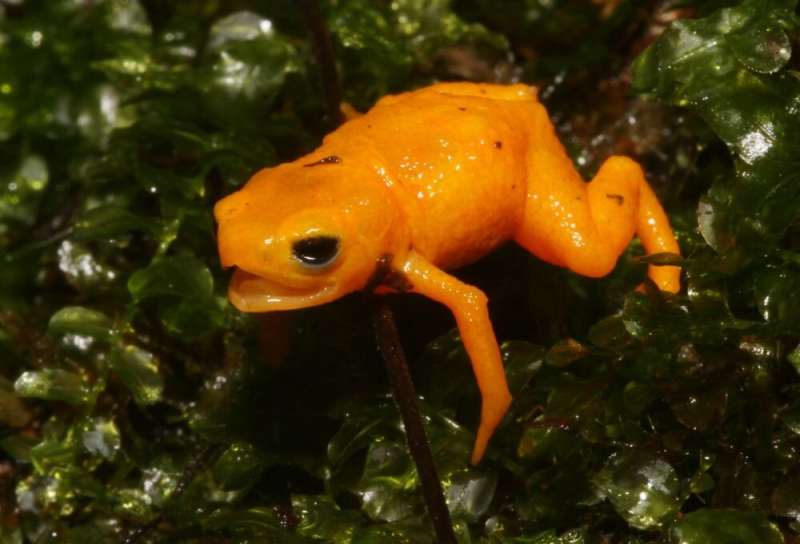Natural history observations of Brachycephalus rotenbergae sp. nov.--mouth gaping defensive behaviour Credit: Nunes et al, 2021, PLOS ONE (CC-BY 4.0, creativecommons.org/licenses/by/4.0/)
A team of researchers from Universidade Estadual Paulista, Universidade Federal do Mato Grosso do Sul and Projeto Dacnis, São Francisco Xavier and Ubatuba has discovered a new species of pumpkin toadlet. In their paper published on the open-access site PLOS ONE, the group describes their study of pumpkin toadlets in Brazil, how they found the new species and what sets it apart from other pumpkin toadlets.
Pumpkin toadlets are a group of related species of bright orange amphibians. They look like tiny frogs, and most are small enough to sit on a thumbnail—many of them are also poisonous. In this new effort, the researchers were studying pumpkin toadlets living in a heavily forested part of Brazil, just south of the Mantiqueira mountains, along its eastern coast—in the state of São Paulo. To date, several species have been identified. To learn more about them, the researchers traveled to the area multiple times between late 2017 and late 2019, collecting samples. The collecting was made easier through the use of a fluorescent light—some of the bones of the tiny creatures light up right through the skin. In all, the team collected 276 specimens which they took back to their lab for study. Each was given a DNA test to identify its species. It was during this part of the study that the researchers discovered that they had captured several examples of a new species, which they promptly named Brachycephalus rotenbergae—after one of the founders of the Brazilian NGO Projeto Danis which works to conserve the forest where the toadlets live.
Further study of the toadlet revealed that like many other pumpkin toadlets, B. rotenbergae is extremely poisonous. They also found some differences from the other species—most notably small dark spots on its head. They also found the species to be slightly smaller than the other pumpkin toadlets. They noted that the toadlets' DNA differed from other pumpkin toadlets by approximately 3%, which was enough to warrant its classification as a new species. The researchers plan to continue their study of the new species, one of the things they would like to know is the purpose of the fluorescent bones.
More information: Ivan Nunes et al. Hidden by the name: A new fluorescent pumpkin toadlet from the Brachycephalus ephippium group (Anura: Brachycephalidae), PLOS ONE (2021). DOI: 10.1371/journal.pone.0244812
Journal information: PLoS ONE
© 2021 Science X Network























